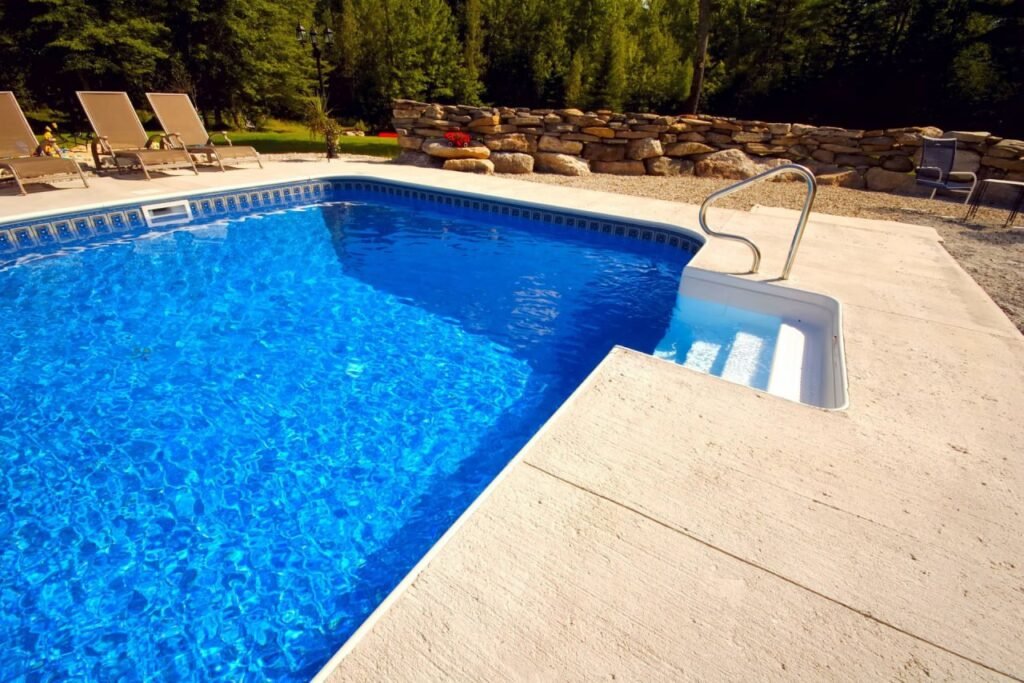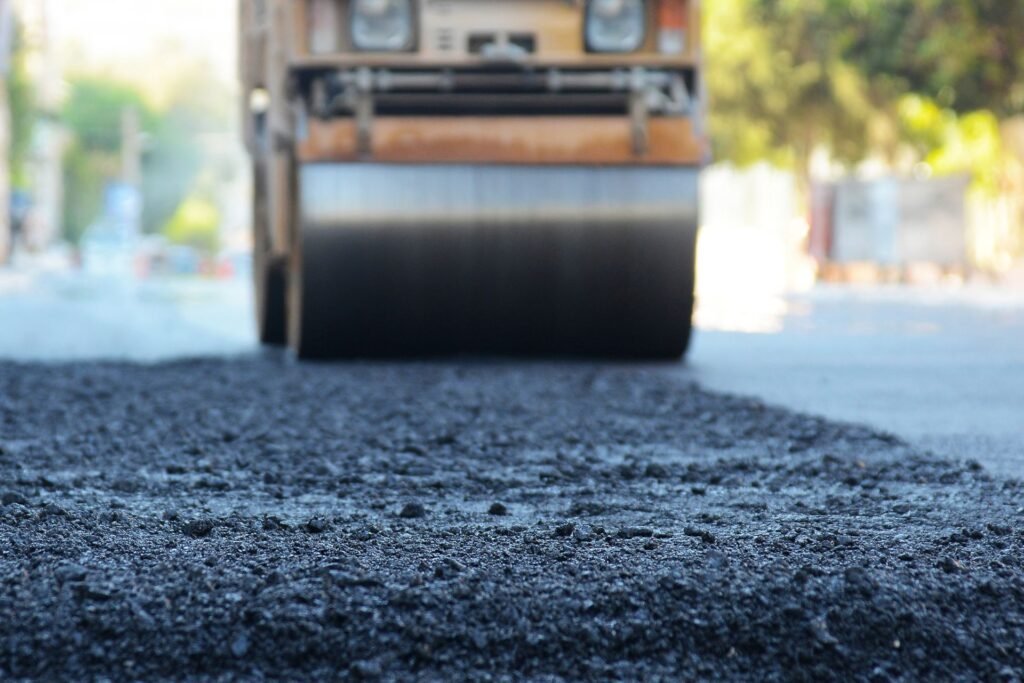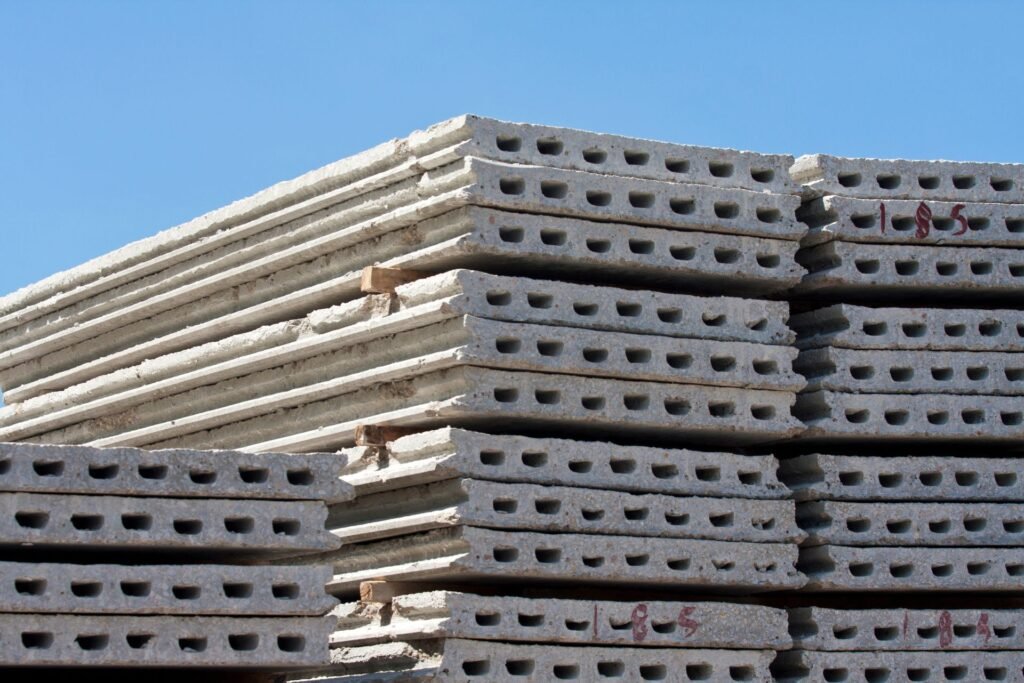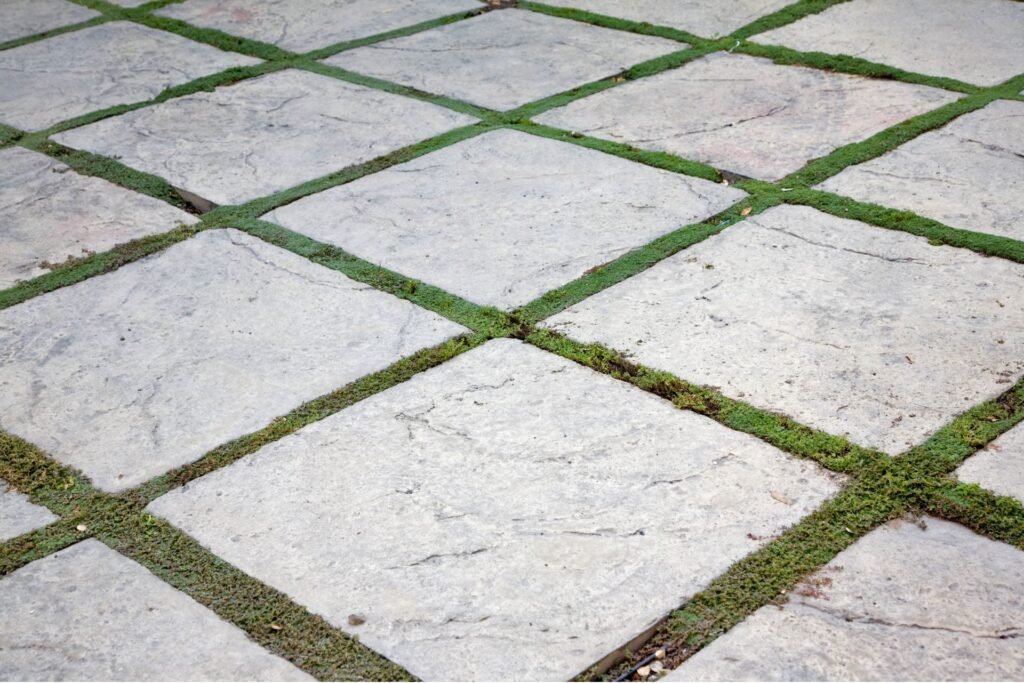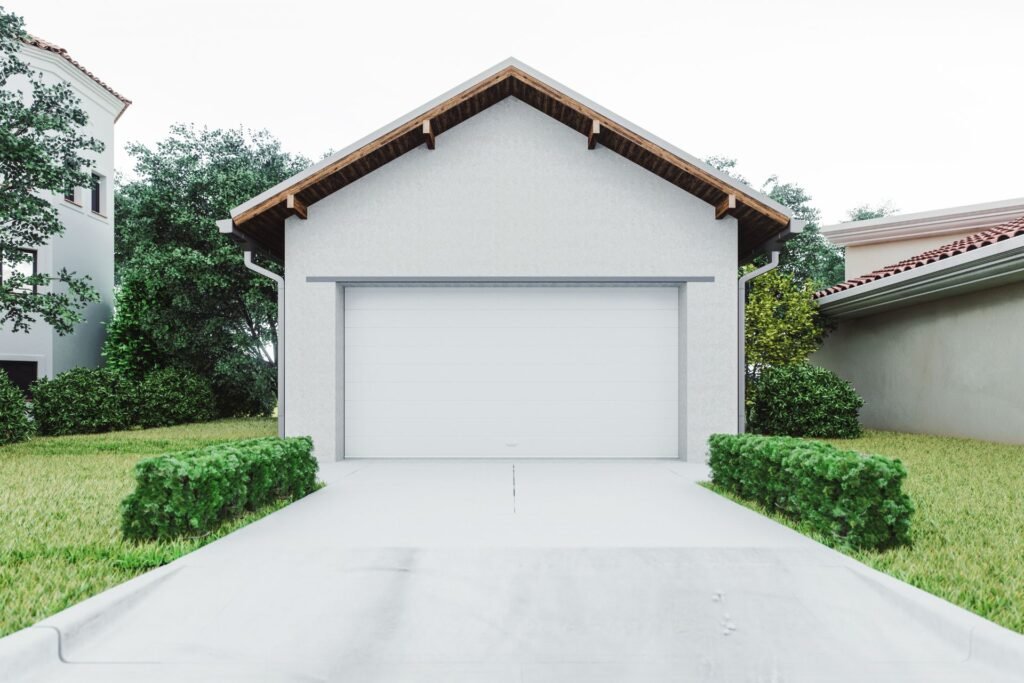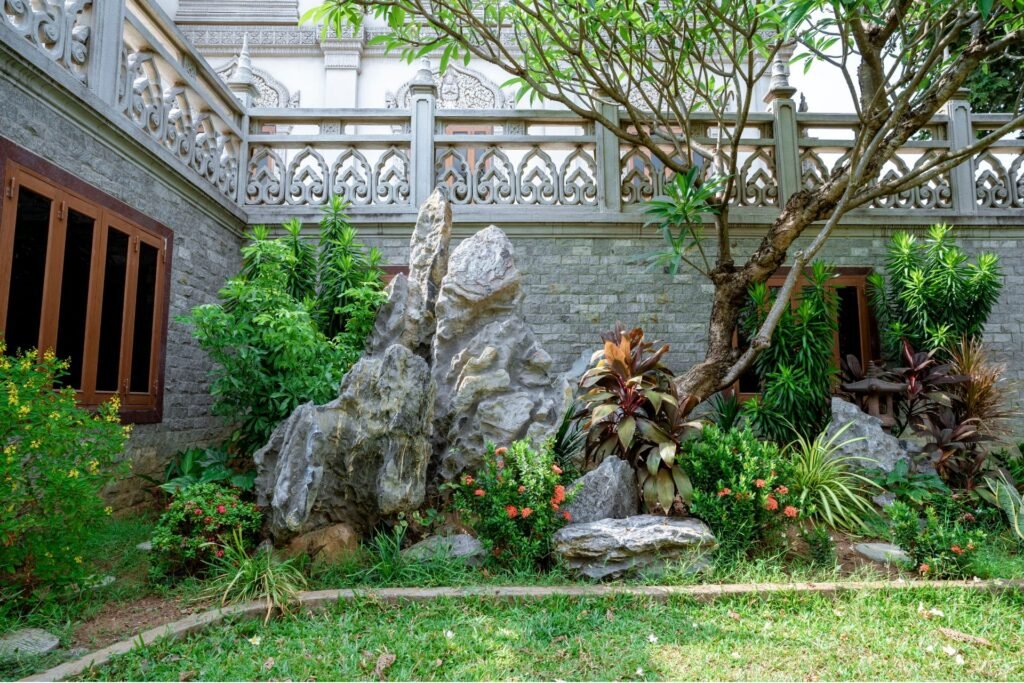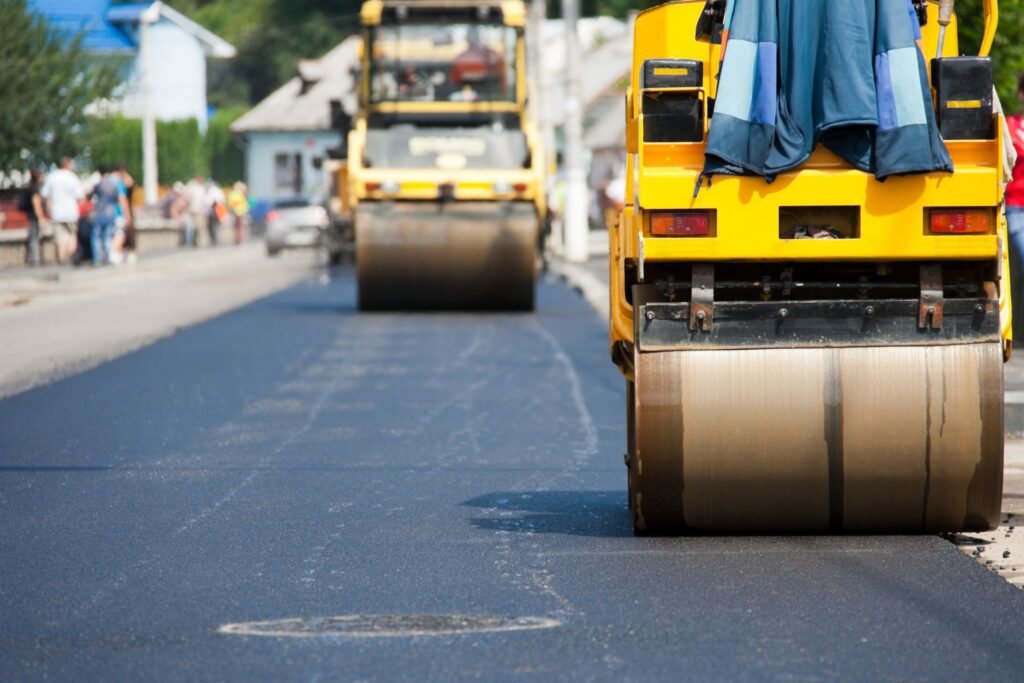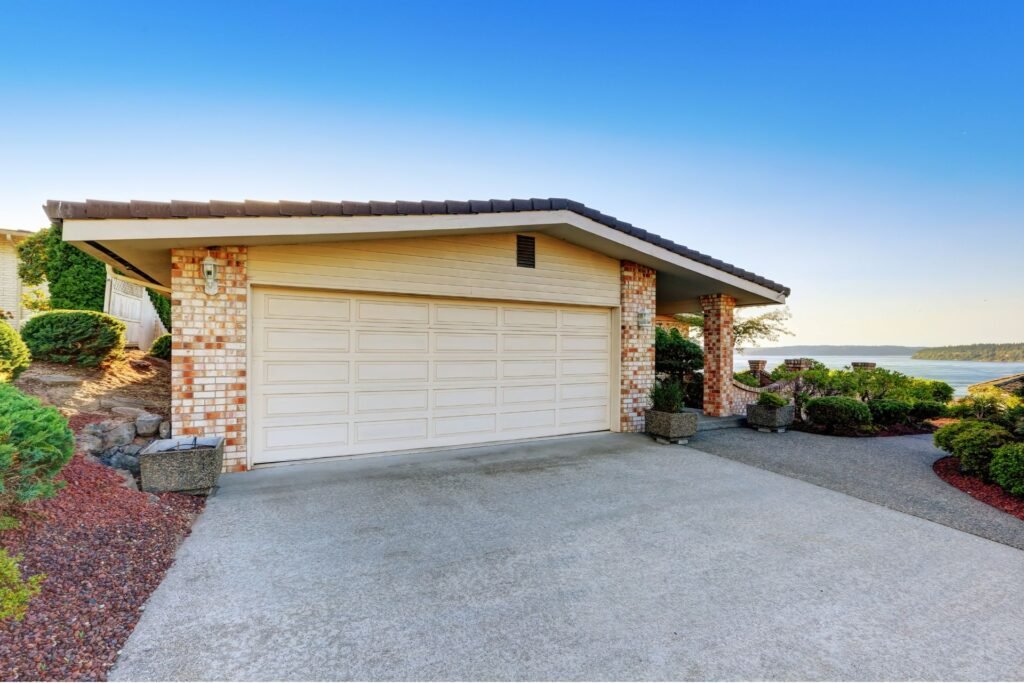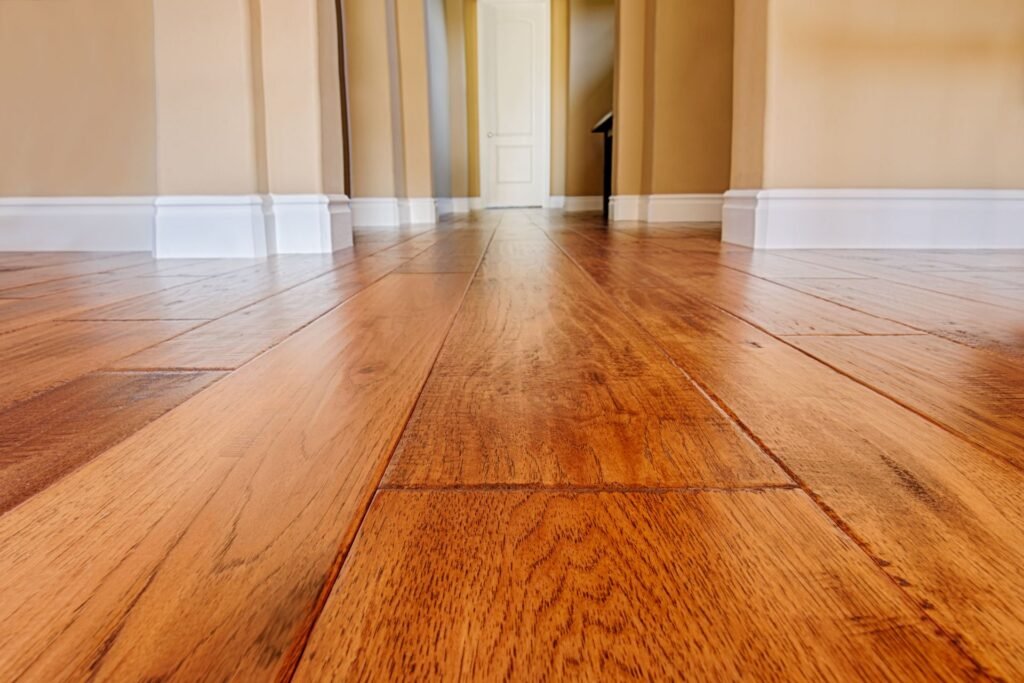Welcome to our in-depth guide on understanding the impact of pool chlorine on concrete surfaces. As a pool owner, you may often wonder about the long-term effects of chlorine on your beautiful pool deck or surrounding concrete structures. In this blog post, we’ll explore why chlorine is essential for maintaining clean and safe pool water, but also how it can potentially harm concrete over time. We’ll dive into the chemistry behind chlorine’s interaction with concrete, signs of damage to look out for, preventative measures you can take, and repair options if your concrete has already been affected. By the end, you’ll have a clear understanding of how to protect your pool’s concrete and ensure it remains in pristine condition for years to come.
Chlorine, essential for pool maintenance, can damage concrete over time. High chlorine levels can cause chemical reactions that lead to erosion, discoloration, and cracks in concrete surfaces. To prevent damage, maintain proper chemical balance, regularly clean and seal concrete, and consider using pool covers to reduce chlorine exposure. If damage occurs, assess the extent and consider professional repair options.
Table of Contents
Understanding Chlorine And Its Role In Pool Maintenance
Maintaining a clean and safe swimming pool hinges significantly on the use of chlorine. This essential chemical serves as the primary line of defense against bacteria, algae, and other harmful microorganisms that can thrive in pool water.
Explanation of Chlorine: What It Is and Why It’s Used in Pools
Chlorine is a chemical element that has been widely used in pool maintenance for decades. It exists in various forms, such as chlorine gas, liquid chlorine, and granular chlorine. When added to pool water, chlorine undergoes a chemical reaction to form hypochlorous acid, a compound that effectively sanitizes the water.
The primary reason chlorine is used in pools is its potent disinfectant properties. It works by breaking down and neutralizing contaminants, making the water safe for swimming. Without chlorine, pools would become breeding grounds for bacteria, viruses, and algae, posing significant health risks to swimmers.
Benefits of Using Chlorine
Using chlorine in pool maintenance comes with numerous benefits that are crucial for keeping the water clean and safe:
1. Sanitization: Chlorine effectively kills bacteria, viruses, and other harmful microorganisms. This ensures that swimmers are not exposed to waterborne illnesses.
2. Algae Control: Algae can quickly turn a pool green and make surfaces slippery. Chlorine prevents algae growth, keeping the water clear and safe.
3. Oxidation: Chlorine helps in breaking down organic matter such as sweat, oils, and other debris introduced by swimmers. This process, known as oxidation, keeps the water clean and clear.
4. Cost-Effectiveness: Chlorine is relatively inexpensive compared to other pool sanitization methods. Its effectiveness and affordability make it a popular choice for pool owners.
Typical Chlorine Levels in a Pool
Maintaining the correct chlorine levels in your pool is crucial for effective water maintenance and safety. The recommended chlorine levels can vary depending on the type of pool and its usage, but generally, they fall within a specific range:
Residential Pools: For most residential pools, the ideal chlorine level is between 1.0 and 3.0 parts per million (ppm). This range ensures the water remains clean and safe without causing irritation to swimmers’ skin or eyes.
Commercial Pools: Public or commercial pools, which typically have higher bather loads, often require a higher chlorine level, usually between 3.0 and 5.0 ppm. This helps manage the increased amount of contaminants introduced by numerous swimmers.
Regular testing of chlorine levels is essential to ensure they remain within the safe range. Pool owners can use test strips or liquid test kits to monitor chlorine levels and adjust the dosage as needed. Automated systems are also available for more precise and continuous monitoring.
Understanding chlorine and its role in pool maintenance is fundamental for anyone responsible for keeping a pool clean and safe. Chlorine’s disinfection power, ability to control algae, and overall cost-effectiveness make it an indispensable component of pool care. By maintaining appropriate chlorine levels, pool owners can ensure a safe and enjoyable swimming environment for everyone.

The Composition Of Concrete
Basic Components of Concrete
Concrete is a fundamental building material composed of three primary ingredients: cement, aggregate, and water.
Cement: Cement is the binding element in concrete, commonly made from limestone, clay, and other minerals. It undergoes a chemical process called hydration when mixed with water, forming a hard, stone-like substance.
Aggregate: Aggregates are the coarse and fine materials, such as gravel, crushed stone, and sand, that provide bulk and strength to the concrete mix. They help to enhance the material’s structural integrity and durability.
Water: Water is essential for the chemical reaction that occurs with cement. The amount and quality of water used in the mix affect the concrete’s strength and workability.
The proportions of these components can vary depending on the specific requirements of the project, but the basic mix follows a general rule of thumb: one part cement, two parts sand, and four parts gravel, with water added to achieve the desired consistency.
How Concrete is Used in Pool Construction
Concrete’s versatility and strength make it an ideal material for pool construction. It is used in various aspects, including:
Decks: Concrete decks provide a durable, non-slip surface around the pool. They can be customized with different textures and finishes to enhance the aesthetic appeal and safety.
Pool Surrounds: Concrete is commonly used for the pool’s coping and surrounding areas. It can be molded into various shapes and sizes, providing a seamless integration with the pool design.
Structural Shells: In many pools, concrete forms the structural shell, ensuring a long-lasting, robust foundation that can withstand the pressures of water and external forces.
Concrete’s adaptability allows for creative and functional pool designs, from sleek modern looks to natural, stone-like finishes.
Properties of Concrete
Concrete is valued in construction for several key properties:
Strength: Concrete’s compressive strength makes it capable of bearing substantial loads, which is crucial for pool decks and structural components. It can be engineered to withstand various pressures, ensuring longevity and stability.
Durability: One of the most notable properties of concrete is its durability. When properly mixed and cured, concrete can resist weathering, chemical attacks, and abrasion, making it a suitable choice for outdoor pool environments.
Porosity: While concrete is strong and durable, it is also porous. This means it can absorb water, which can lead to issues like cracking if not properly treated. To mitigate this, sealants and waterproofing treatments are often applied to concrete used in pool construction.
Understanding the composition and properties of concrete helps in making informed decisions about its use in pool projects. Properly proportioned and treated, concrete can provide a beautiful, long-lasting solution for both functional and aesthetic elements of pool design.

How Chlorine Interacts With Concrete
Chlorine, commonly found in swimming pools, is essential for keeping the water clean and free from harmful microorganisms. However, its interaction with concrete surfaces, such as pool decks and concrete pools, can lead to several issues over time. Understanding these interactions is crucial for maintaining the integrity and aesthetics of your concrete structures.
Chemical Reactions: How Chlorine Can Affect Concrete Chemically
When chlorine comes into contact with concrete, it can initiate various chemical reactions that may compromise the concrete’s integrity. Chlorine, in its different forms (gas, liquid, or solid), can penetrate the porous structure of concrete. Once inside, it reacts with the calcium compounds present in concrete. This reaction leads to the formation of calcium chloride, which is highly soluble in water. Over time, this process can result in the leaching out of essential minerals from the concrete, weakening its overall structure.
Additionally, chlorine can contribute to the process known as carbonation. This occurs when carbon dioxide from the air reacts with the calcium hydroxide in the concrete to form calcium carbonate. While carbonation can sometimes increase the surface hardness of concrete, it also lowers the pH of the concrete, making it more susceptible to further chemical attack and reducing its durability.
Physical Impact: Erosion, Discoloration, and Potential Structural Damage
The physical effects of chlorine on concrete are often more visible than the chemical reactions. One of the most noticeable impacts is erosion. Chlorine, especially in high concentrations, can accelerate the erosion of the concrete surface. This erosion not only affects the aesthetics but also exposes the inner layers of concrete to further chemical and physical damage.
Discoloration is another common issue. Chlorine can cause concrete to develop unsightly stains and discoloration, often turning it a dull gray or even causing patches of white or yellow. This discoloration results from the reaction between chlorine and the various minerals within the concrete, leading to uneven fading and staining.
Structural damage is perhaps the most concerning impact. Over time, the continuous exposure to chlorine can cause micro-cracks in the concrete to expand. These cracks can allow more chlorine and water to penetrate deeper into the concrete, exacerbating the chemical reactions and physical erosion. In severe cases, this can lead to significant structural damage, compromising the safety and longevity of the concrete structure.
Factors Influencing Damage: Concentration of Chlorine, Frequency of Exposure, and Age of the Concrete
Several factors influence the extent of damage chlorine can cause to concrete. One of the primary factors is the concentration of chlorine. Higher concentrations lead to more intense and faster chemical reactions, increasing the rate of erosion and discoloration. It is essential to monitor and control chlorine levels in pool water to mitigate these effects.
The frequency of exposure also plays a crucial role. Concrete that is regularly exposed to chlorinated water will suffer more damage than concrete with only occasional exposure. For instance, a pool deck that frequently gets splashed with chlorinated water will show signs of wear and tear much faster than a concrete walkway farther from the pool.
The age of the concrete is another significant factor. Newer concrete tends to be more resilient and less porous, offering better resistance to chlorine damage. However, as concrete ages, it becomes more porous and susceptible to chemical reactions and physical erosion. Older concrete structures require more diligent maintenance and protection measures to prevent chlorine-induced damage.
Understanding how chlorine interacts with concrete chemically and physically is vital for maintaining the durability and appearance of your concrete structures. By considering factors such as chlorine concentration, frequency of exposure, and the age of the concrete, you can take proactive steps to minimize damage and extend the lifespan of your concrete surfaces. Regular maintenance, sealing, and appropriate chemical treatments can help protect concrete from the adverse effects of chlorine, ensuring that your pool area remains both functional and visually appealing for years to come.
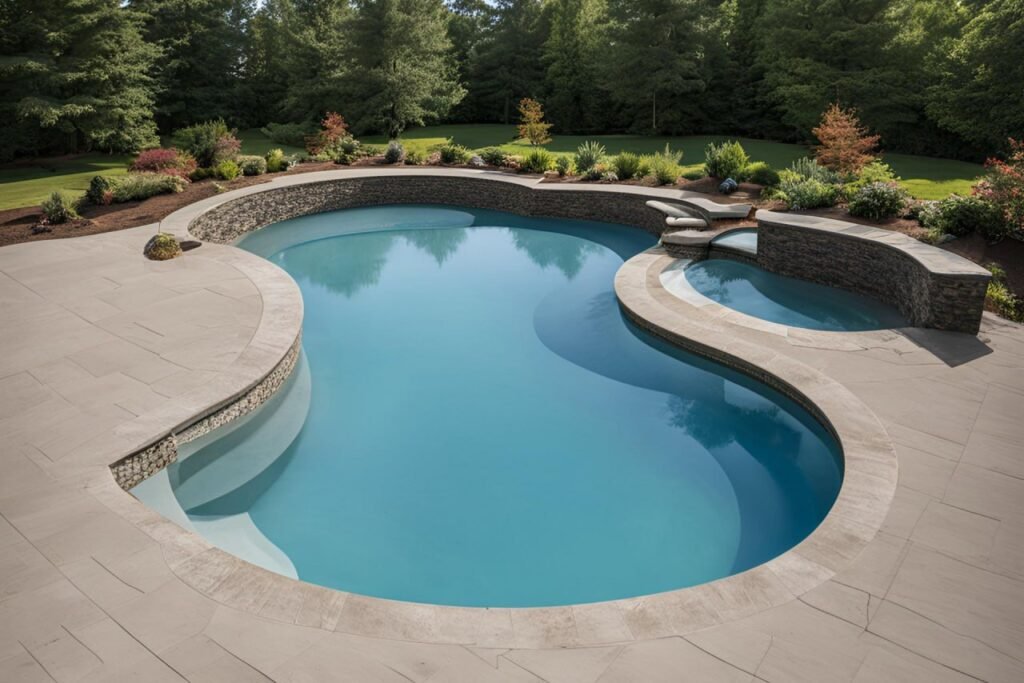
Signs Of Chlorine Damage To Concrete
Concrete surfaces around swimming pools are regularly exposed to chlorine, which is essential for keeping the pool water clean and safe. However, over time, chlorine can have detrimental effects on the concrete. Understanding the signs of chlorine damage is crucial for maintaining the integrity and aesthetics of your pool area.
Visual Indicators
1. Cracks: One of the most obvious signs of chlorine damage is the appearance of cracks on the concrete surface. These can start as tiny hairline fractures but can expand over time due to continued exposure to chlorine and water. Cracks compromise the structural integrity of the concrete, making it more susceptible to further damage.
2. Discoloration: Chlorine can cause noticeable discoloration on concrete surfaces. Initially, you might observe slight fading or lightening of the concrete color. Over time, this discoloration can become more pronounced, with patches of white or yellow stains appearing on the surface. This not only affects the look of the concrete but can also indicate underlying damage.
3. Surface Degradation: Another visual indicator is surface degradation, where the top layer of the concrete starts to wear away. This can lead to a rough, uneven surface that is both unsightly and uncomfortable to walk on. Surface degradation is a clear sign that the concrete is being chemically eroded by the chlorine.
Structural Symptoms
1. Weakened Areas: Chlorine damage doesn’t just affect the surface; it can also penetrate deeper into the concrete, leading to weakened areas. These spots may feel softer underfoot or sound hollow when tapped. Weak spots in the concrete can be a precursor to more significant structural issues.
2. Crumbling Edges: The edges of concrete slabs are particularly vulnerable to chlorine damage. Over time, you might notice the edges starting to crumble or chip away. This not only detracts from the visual appeal but also poses a safety hazard. Crumbling edges are a sign that the concrete is losing its strength and durability.
Long-term Effects
1. Potential for More Serious Structural Issues: If the early signs of chlorine damage are ignored, the concrete can develop more serious structural problems. These might include deep cracks that penetrate through the slab, widespread surface pitting, and extensive weakening of the concrete. Over the long term, this can lead to significant repair costs or even the need to replace entire sections of the concrete.
2. Compromised Safety: Severely damaged concrete can become a safety hazard, especially in high-traffic areas around the pool. Slips, trips, and falls are more likely to occur on uneven, cracked, or crumbling surfaces. Ensuring the concrete remains in good condition is essential for the safety of all pool users.
3. Increased Maintenance Costs: Addressing chlorine damage early can save on extensive repair costs down the line. Regular inspections and prompt repairs are crucial to maintaining the concrete’s integrity and avoiding expensive fixes.
Recognizing and addressing the signs of chlorine damage to concrete is vital for preserving both the aesthetic appeal and structural integrity of your pool area. By keeping an eye out for visual indicators like cracks, discoloration, and surface degradation, and by being aware of structural symptoms such as weakened areas and crumbling edges, you can take timely action to mitigate damage and extend the life of your concrete surfaces.
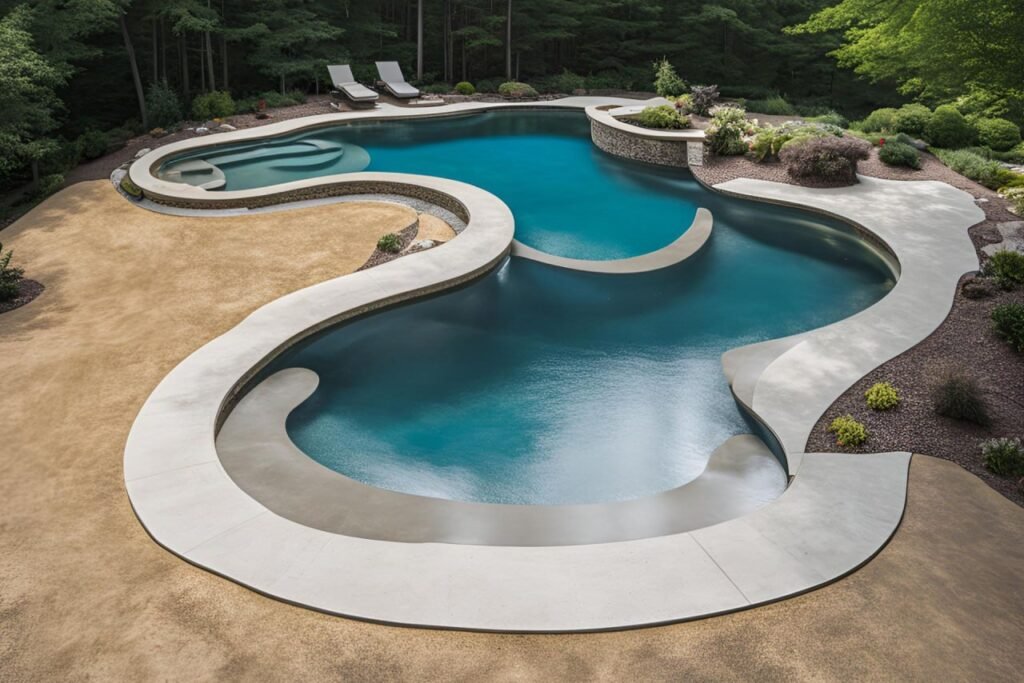
Preventative Measures To Protect Concrete From Chlorine Damage
Concrete surfaces, especially those surrounding pools, are prone to damage from chlorine over time. Chlorine, while essential for maintaining clean and safe pool water, can be harsh on concrete if not properly managed. Here are some key preventative measures to protect your concrete from chlorine damage:
Regular Maintenance: Cleaning and Sealing Concrete Surfaces
One of the most effective ways to protect concrete from chlorine damage is through regular maintenance. This involves both cleaning and sealing the concrete surfaces.
Cleaning: Routinely clean the concrete surfaces around your pool to remove chlorine residues and other debris. This can be done using a mild detergent and water, or a specialized concrete cleaner. Regular cleaning prevents chlorine from penetrating the surface and causing long-term damage.
Sealing: After cleaning, it’s crucial to seal the concrete. Sealing creates a protective barrier that prevents chlorine and other chemicals from soaking into the concrete. Sealers should be applied every 1-3 years, depending on the type and quality of the sealer used. A high-quality sealer will provide a durable shield against chlorine, UV rays, and other damaging elements.
Using Pool Covers: How They Can Reduce Chlorine Exposure
Pool covers are not just for keeping debris out of your pool; they also play a significant role in protecting the concrete surfaces around it.
Reduction of Chlorine Exposure: By covering your pool when it’s not in use, you can significantly reduce the amount of chlorine that evaporates into the air and settles on surrounding concrete surfaces. This helps to minimize the chemical exposure that can lead to concrete deterioration.
Additional Benefits: Besides reducing chlorine exposure, pool covers help maintain water temperature, reduce water evaporation, and lower the need for additional chemicals, thus creating a more balanced and less harsh environment for your concrete.
Proper Chemical Balance: Keeping Chlorine Levels Within Recommended Ranges
Maintaining the proper chemical balance in your pool is essential for protecting both the water quality and the surrounding concrete.
Chlorine Levels: Keeping chlorine levels within the recommended range (usually between 1.0 and 3.0 ppm) is crucial. High chlorine levels can accelerate the wear and tear on concrete surfaces. Regularly test your pool water and adjust the chlorine levels as needed to ensure they stay within safe limits.
Balanced pH Levels: In addition to chlorine, maintaining a balanced pH level (between 7.2 and 7.8) is vital. An imbalanced pH can cause the chlorine to become more aggressive, increasing the risk of damage to concrete. Use pH adjusters as necessary to keep your pool water balanced.
Use of Stabilizers: Chlorine stabilizers, like cyanuric acid, can help protect chlorine from being broken down by sunlight, thereby maintaining effective chlorine levels with less frequent additions. This helps in reducing the overall chlorine exposure to the concrete surfaces.
By implementing these preventative measures—regular maintenance, using pool covers, and keeping a proper chemical balance—you can significantly extend the life of your concrete surfaces and protect them from the harmful effects of chlorine. Taking these steps not only preserves the aesthetic appeal of your pool area but also ensures a safe and enjoyable swimming environment.

Repairing Chlorine-Damaged Concrete
Concrete pools and surrounds can face significant wear and tear over time, especially from exposure to pool chemicals like chlorine. Repairing chlorine-damaged concrete is essential to maintain its structural integrity and appearance. Here’s a comprehensive guide to help you through the process:
Assessing the Damage: How to Evaluate the Extent of Chlorine Damage
The first step in repairing chlorine-damaged concrete is to assess the extent of the damage. Begin by conducting a thorough inspection of the concrete surface. Look for signs such as discoloration, pitting, scaling, or cracks. These are common indicators that chlorine has started to degrade the concrete.
Discoloration: Chlorine can cause the concrete to lose its original color, turning it whitish or dull.
Pitting and Scaling: These are small holes or flakes on the surface of the concrete, indicating that the material is breaking down.
Cracks: Cracks can form as a result of the concrete’s weakened state from chlorine exposure. These need to be carefully inspected to determine their depth and length.
To accurately evaluate the damage, you might need to use tools like a concrete moisture meter, which can help you understand how deep the damage has penetrated.
DIY Repairs: Simple Fixes for Minor Damage
If the damage to your concrete is minor, you might be able to handle the repairs yourself. Here are some DIY methods to address superficial issues:
Cleaning and Patching: Begin by cleaning the affected area thoroughly with a concrete cleaner to remove any debris, algae, or dirt. Once clean, use a concrete patching compound to fill in small pits and cracks. Follow the manufacturer’s instructions for the best results.
Sealing: Applying a high-quality concrete sealer can help protect the surface from further chlorine damage. Sealers create a protective layer that repels water and chemicals, prolonging the life of your concrete. Ensure the surface is clean and dry before applying the sealer.
While DIY repairs can be effective for minor issues, they are not always suitable for more severe damage.
Professional Repairs: When to Call in Experts and What to Expect
For significant or structural damage, it’s best to call in professional concrete repair specialists. Here’s what you can expect when working with experts:
Thorough Inspection: Professionals will conduct a detailed inspection to assess the extent of the damage and identify underlying issues that might not be visible on the surface.
Advanced Repair Techniques: Depending on the severity, they might use advanced techniques such as epoxy injections for deep cracks or resurfacing for extensive surface damage. These methods require specialized equipment and expertise.
Quality Assurance: Professional repairs come with a quality assurance guarantee. Experts ensure that repairs are not only effective but also long-lasting, often providing warranties for their work.
Preventative Measures: Besides repairing the damage, professionals can offer advice and solutions to prevent future chlorine damage. This might include recommending better maintenance practices or applying industrial-grade sealers.
Calling in professionals ensures that the repair job is done correctly, reducing the risk of recurring issues and preserving the integrity of your concrete structures.
Whether you’re dealing with minor or major chlorine damage, understanding the extent of the damage and choosing the appropriate repair method is crucial. Regular maintenance and timely repairs can keep your concrete pool surrounds looking pristine and ensure they remain structurally sound for years to come.

Alternative Pool Sanitizing Methods
Swimming pool maintenance often conjures images of chlorine, the go-to sanitizer for keeping pool water crystal clear and free from harmful bacteria. However, there are several alternative sanitizing methods available that can provide effective, and sometimes more eco-friendly, solutions. Here, we’ll delve into some popular chlorine alternatives, discuss their pros and cons, and explore real-world case studies showcasing their success.
Chlorine Alternatives: Saltwater Systems, Ozone Generators, UV Sanitizers
Saltwater Systems
Saltwater pools use a salt chlorine generator to convert salt into chlorine through a process called electrolysis. This method provides a steady, lower level of chlorine compared to traditional methods.
Ozone Generators
Ozone generators sanitize pool water by producing ozone gas (O3), a powerful oxidizer that destroys bacteria and viruses more effectively than chlorine. Ozone breaks down quickly, leaving minimal chemical residue in the water.
UV Sanitizers
UV sanitizers use ultraviolet light to kill microorganisms as the water passes through a UV light chamber. This method doesn’t add any chemicals to the water, making it a highly eco-friendly option.
Pros and Cons: Effectiveness, Cost, and Impact on Concrete
Effectiveness
Saltwater Systems: These systems maintain a constant, lower level of chlorine, which can be gentler on the skin and eyes. However, they still rely on chlorine for sanitation.
Ozone Generators: Highly effective at killing pathogens, ozone generators provide superior sanitation. However, they do not maintain residual sanitation, so a small amount of chlorine or another sanitizer might still be needed.
UV Sanitizers: UV sanitizers are excellent at neutralizing bacteria and viruses, but like ozone, they do not provide a residual effect, meaning another form of sanitizer may be required for continuous protection.
Cost
Saltwater Systems: Initial installation can be more expensive than traditional chlorine systems, but ongoing costs are typically lower due to reduced chemical purchases.
Ozone Generators: These systems can be costly upfront and require regular maintenance, but they can lower overall chemical costs in the long run.
UV Sanitizers: UV systems have a moderate initial cost and low operating costs, but bulbs need periodic replacement, adding to maintenance expenses.
Impact on Concrete
Saltwater Systems: Salt can be corrosive over time, potentially causing damage to concrete surfaces and surrounding structures if not properly managed.
Ozone Generators: Ozone does not have a corrosive impact on concrete, making it a safer option for pool surfaces.
UV Sanitizers: Since UV systems do not introduce chemicals into the water, they have no adverse effects on concrete pool surfaces.
Case Studies: Examples of Successful Alternative Sanitizing Methods
Saltwater Pool Case Study
A residential pool owner in Florida switched to a saltwater system to reduce the harsh effects of chlorine on their family’s skin. Over five years, the pool has maintained excellent water quality with minimal maintenance, and the family enjoys swimming without the strong chlorine odor.
Ozone Generator Case Study
A hotel in California installed an ozone generator to provide a more luxurious experience for guests. The system significantly improved water clarity and reduced the need for additional chemicals, leading to lower maintenance costs and higher guest satisfaction.
UV Sanitizer Case Study
A public pool in New York adopted UV sanitizers to meet stringent health regulations while minimizing chemical use. The UV system has effectively kept the water pathogen-free, and feedback from swimmers indicates a noticeable improvement in water quality and comfort.
Exploring alternative pool sanitizing methods can lead to more sustainable, cost-effective, and user-friendly options. While each method has its unique benefits and challenges, saltwater systems, ozone generators, and UV sanitizers all present viable alternatives to traditional chlorine. By understanding their pros and cons, and learning from successful case studies, pool owners can make informed decisions to enhance their swimming experience while maintaining a healthy pool environment.

Expert Tips For Pool Maintenance
Maintaining a pool can sometimes feel like a daunting task, but with the right tips and guidance, it can become a manageable and even enjoyable part of your routine. In this section, we provide expert advice on preventing and addressing chlorine damage, recommend the best products for maintenance, and answer some frequently asked questions to help you keep your pool in top condition.
Advice from Pool Maintenance Professionals: Best Practices for Preventing and Addressing Chlorine Damage
Chlorine is essential for keeping your pool water clean and safe, but it can also cause damage if not managed properly. Here are some expert tips to help you prevent and address chlorine damage:
1. Regular Testing and Balancing: One of the most important aspects of pool maintenance is regularly testing your water’s chemical levels. Aim to test your pool water at least twice a week. Keeping the chlorine levels within the recommended range (1-3 ppm) helps prevent damage to your pool’s surfaces and equipment.
2. Proper Chlorine Distribution: Instead of adding chlorine directly to the pool, use a chlorinator or floating dispenser. This ensures a more even distribution and reduces the risk of high concentration spots that can cause damage.
3. Shock Treatment: Shock your pool once a week or after heavy use. This involves adding a higher dose of chlorine to the water to eliminate contaminants. Follow the manufacturer’s instructions carefully to avoid over-chlorination.
4. Regular Cleaning: Clean your pool regularly to remove debris and prevent algae growth. Pay special attention to areas where debris tends to accumulate, such as corners and steps. This not only keeps your pool looking great but also reduces the need for high chlorine levels.
5. Maintain Pool Equipment: Ensure that your pool’s filtration and circulation systems are working efficiently. Clean or replace filters as needed and check for any signs of wear and tear. Well-maintained equipment helps in evenly distributing chlorine and maintaining water quality.
Product Recommendations: Sealants, Cleaners, and Other Maintenance Tools
Using the right products can make a significant difference in maintaining your pool. Here are some top recommendations from pool maintenance professionals:
- Sealants: To protect your pool surfaces from chlorine damage, use high-quality sealants. Look for pool sealants that create a protective barrier, helping to prevent staining and deterioration.
- Cleaners: Effective pool cleaners are essential for maintaining water clarity and hygiene. Both automatic and manual pool cleaners can help you keep your pool spotless with minimal effort.
- Maintenance Tools: Invest in a good pool maintenance kit that includes a skimmer, brush, and vacuum. Comprehensive sets that cover all your basic cleaning needs are widely available.
- Chemical Testing Kits: Accurate testing is crucial for balanced pool chemistry. Easy-to-use and reliable chemical testing kits are essential tools for monitoring your water’s chemical levels.
By following these expert tips, using recommended products, and staying informed about common concerns, you can keep your pool in pristine condition all year round. Regular maintenance not only enhances your swimming experience but also prolongs the life of your pool and its components.
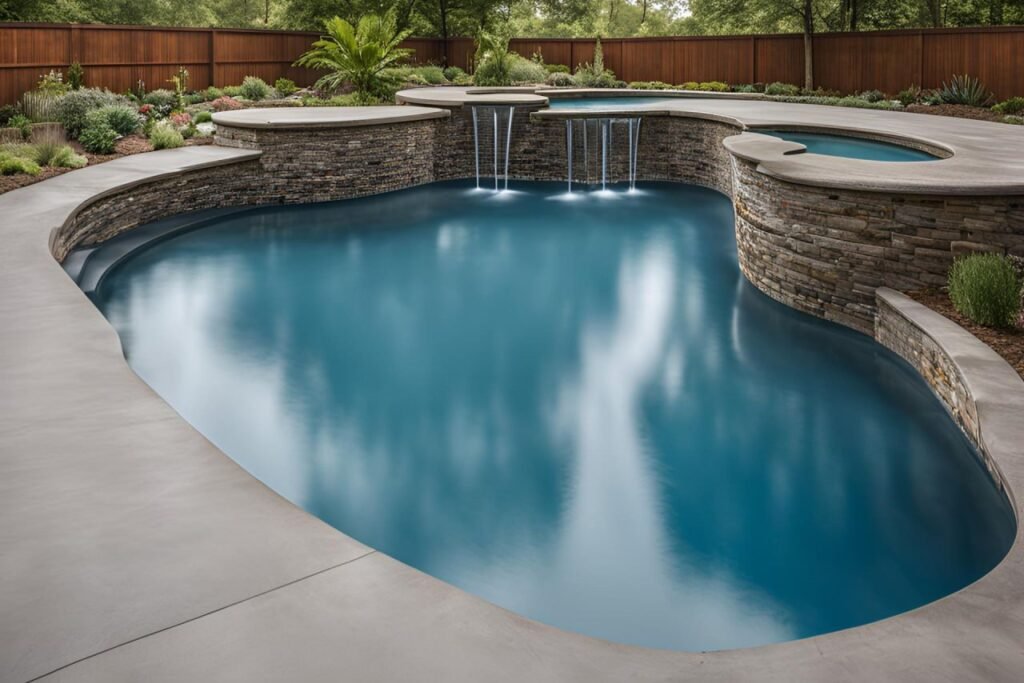
FAQs: About Will the Chlorine From My Pool Damage The Concrete
How does chlorine damage concrete?
Chlorine can chemically react with the components of concrete, leading to erosion, discoloration, and structural damage over time. High chlorine levels and frequent exposure can accelerate these effects, weakening the concrete and causing cracks and crumbling.
What are the signs of chlorine damage on concrete?
Signs of chlorine damage on concrete include visible cracks, discoloration, surface degradation, and weakened areas that may crumble or chip away. Over time, these issues can worsen, leading to more significant structural problems.
Can chlorine cause long-term structural damage to concrete?
Yes, prolonged exposure to high levels of chlorine can cause long-term structural damage to concrete. The chemical reactions between chlorine and concrete can weaken the material, leading to serious issues that may require extensive repairs.
How can I prevent chlorine from damaging my pool’s concrete?
To prevent chlorine damage, maintain proper chemical balance in your pool, regularly clean and seal concrete surfaces, and use pool covers to reduce chlorine exposure. Additionally, consider using alternative sanitizing methods to minimize chlorine use.
What are some alternative pool sanitizing methods?
Alternative pool sanitizing methods include saltwater systems, ozone generators, and UV sanitizers. These methods can effectively keep your pool clean with less reliance on chlorine, reducing the risk of concrete damage.
How often should I seal my pool’s concrete surfaces?
Sealing concrete surfaces around your pool should be done every 1-3 years, depending on usage and exposure to chemicals. Regular sealing helps protect the concrete from chemical damage, including chlorine, and extends its lifespan.
Can I repair chlorine-damaged concrete myself?
Minor chlorine damage, such as small cracks or surface discoloration, can often be repaired with DIY methods using concrete patching products. However, significant damage may require professional assessment and repair to ensure structural integrity.
What should I look for when hiring a professional to repair chlorine-damaged concrete?
When hiring a professional, look for experienced contractors with expertise in concrete repair and pool maintenance. Check reviews, ask for references, and ensure they use high-quality materials and methods for lasting repairs.
Is it safe to use pool covers to protect concrete from chlorine damage?
Yes, using pool covers is an effective way to protect concrete from chlorine damage. Covers reduce the amount of chlorine exposure and help maintain chemical balance, preventing erosion and discoloration of the concrete.
How can I maintain the proper chemical balance in my pool to avoid concrete damage?
Regularly test your pool water and adjust chlorine levels to stay within the recommended range. Use appropriate chemical balancing products, follow manufacturer guidelines, and consult with pool maintenance professionals if needed to ensure safe and effective pool care.
Conclusion
In conclusion, understanding the interaction between chlorine and concrete is crucial for maintaining the longevity and aesthetics of your pool area. Chlorine, while essential for keeping pool water clean and safe, can cause concrete surfaces to deteriorate over time if not properly managed. Regular maintenance, including rinsing down the concrete, using sealants, and promptly addressing any signs of damage, can significantly mitigate these effects. Stay proactive and vigilant in your pool maintenance to ensure a durable and attractive pool environment. If you have any experiences to share or questions to ask, we encourage you to join the conversation in the comments below.
About the Author:
Mike Veail is a recognized digital marketing expert with over 6 years of experience in helping tradespeople and small businesses thrive online. A former quantity surveyor, Mike combines deep industry knowledge with hands-on expertise in SEO and Google Ads. His marketing strategies are tailored to the specific needs of the trades sector, helping businesses increase visibility and generate more leads through proven, ethical methods.
Mike has successfully partnered with numerous companies, establishing a track record of delivering measurable results. His work has been featured across various platforms that showcase his expertise in lead generation and online marketing for the trades sector.
Learn more about Mike's experience and services at https://theleadguy.online or follow him on social media:

